Reflective Analysis of Clinical Incident
VerifiedAdded on 2023/01/06
|8
|2587
|74
AI Summary
This document provides a reflective analysis of a clinical incident involving a patient who experienced sepsis after hip surgery. It discusses the stages of the clinical reasoning cycle, the lessons learned from applying the cycle, and the Registered Nurse Standards for Practice in decision making.
Contribute Materials
Your contribution can guide someone’s learning journey. Share your
documents today.
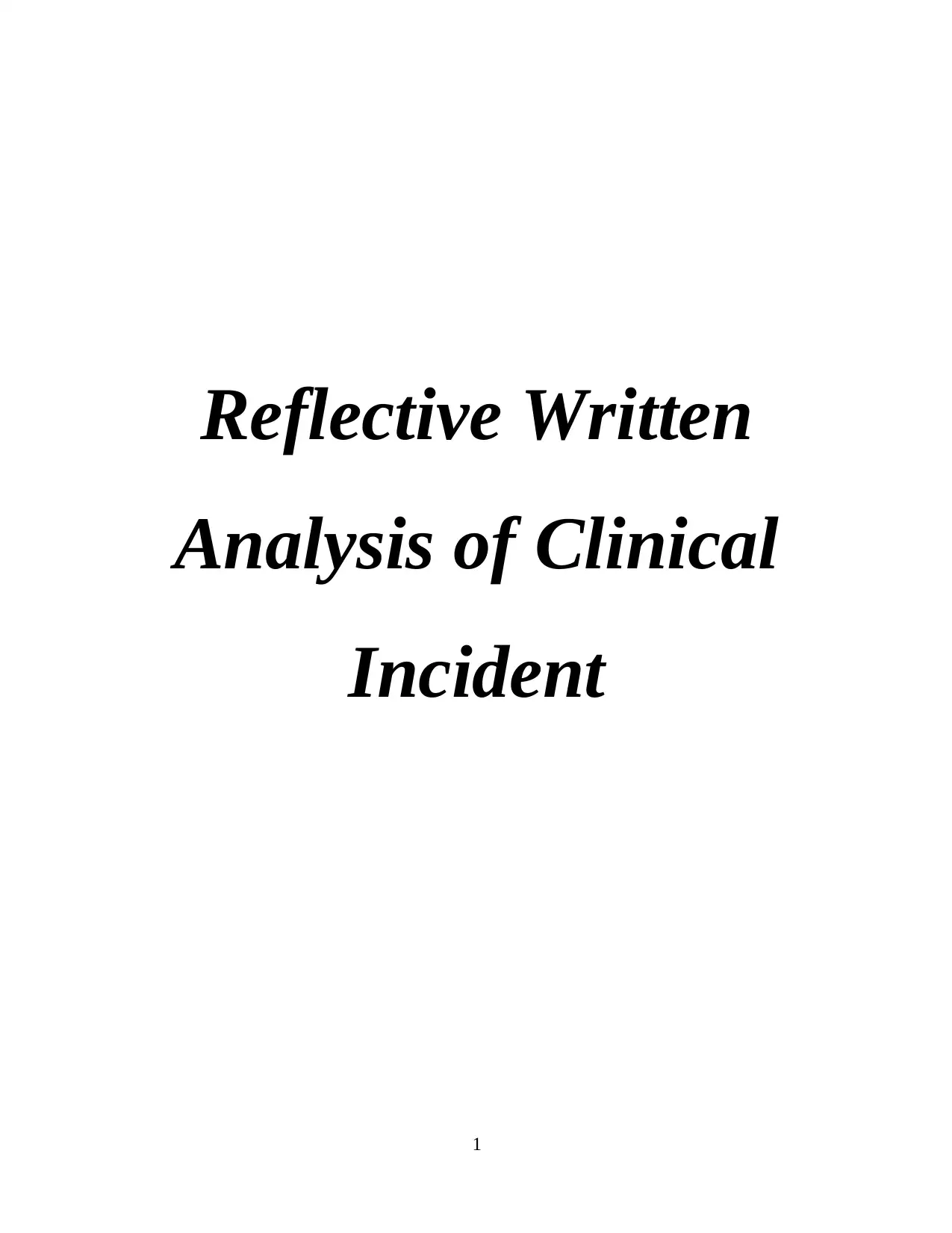
Reflective Written
Analysis of Clinical
Incident
1
Analysis of Clinical
Incident
1
Secure Best Marks with AI Grader
Need help grading? Try our AI Grader for instant feedback on your assignments.
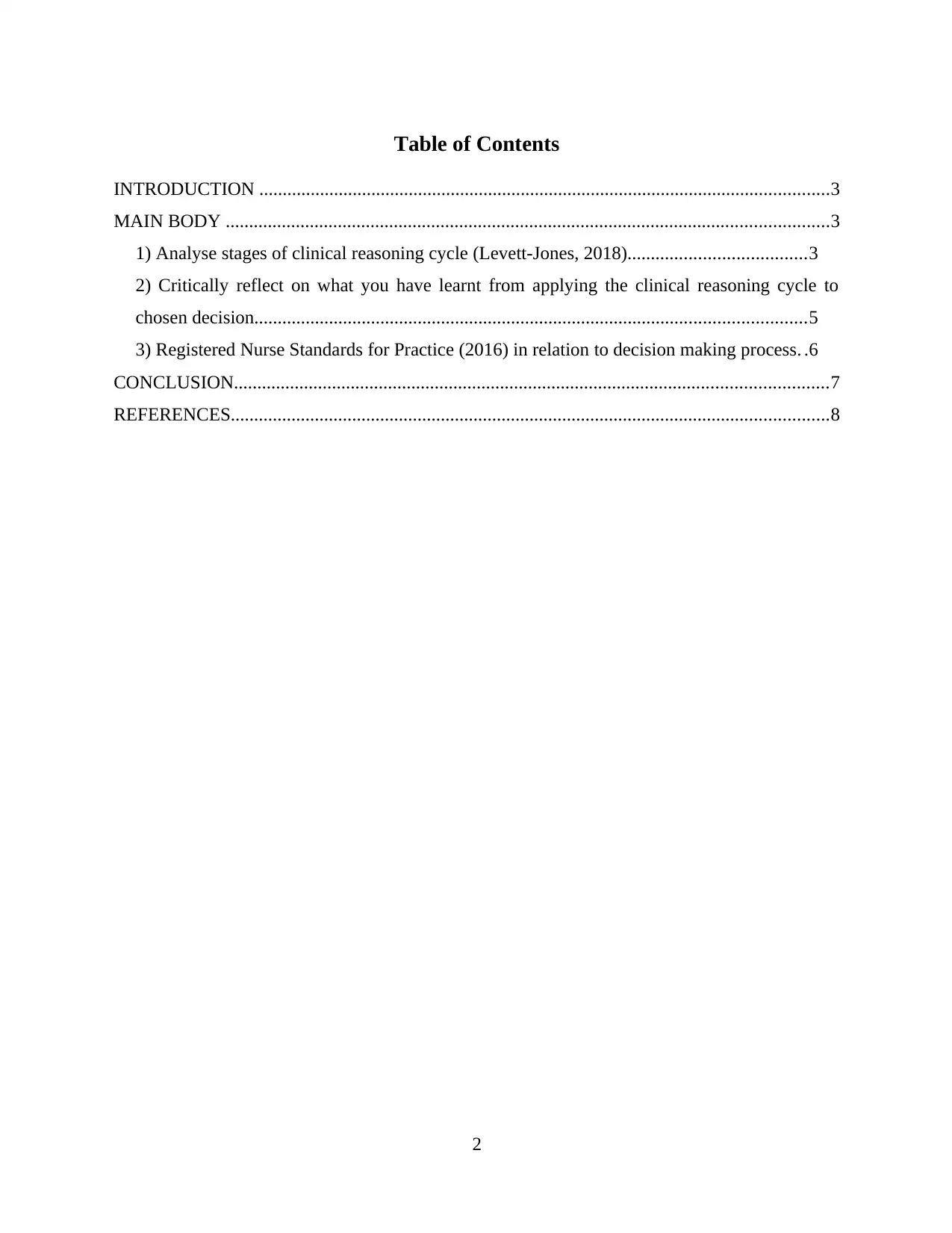
Table of Contents
INTRODUCTION ..........................................................................................................................3
MAIN BODY .................................................................................................................................3
1) Analyse stages of clinical reasoning cycle (Levett-Jones, 2018)......................................3
2) Critically reflect on what you have learnt from applying the clinical reasoning cycle to
chosen decision......................................................................................................................5
3) Registered Nurse Standards for Practice (2016) in relation to decision making process. .6
CONCLUSION...............................................................................................................................7
REFERENCES................................................................................................................................8
2
INTRODUCTION ..........................................................................................................................3
MAIN BODY .................................................................................................................................3
1) Analyse stages of clinical reasoning cycle (Levett-Jones, 2018)......................................3
2) Critically reflect on what you have learnt from applying the clinical reasoning cycle to
chosen decision......................................................................................................................5
3) Registered Nurse Standards for Practice (2016) in relation to decision making process. .6
CONCLUSION...............................................................................................................................7
REFERENCES................................................................................................................................8
2
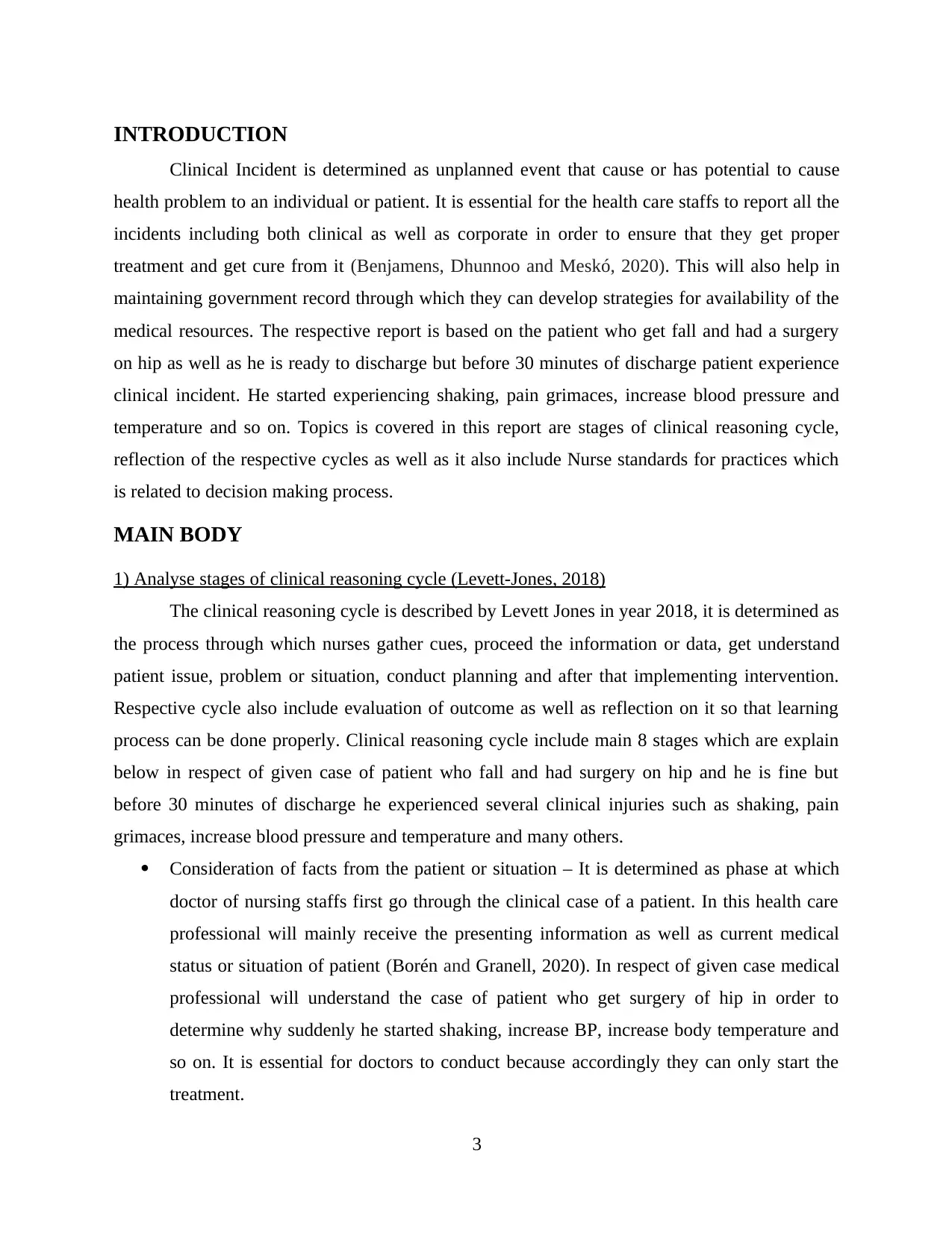
INTRODUCTION
Clinical Incident is determined as unplanned event that cause or has potential to cause
health problem to an individual or patient. It is essential for the health care staffs to report all the
incidents including both clinical as well as corporate in order to ensure that they get proper
treatment and get cure from it (Benjamens, Dhunnoo and Meskó, 2020). This will also help in
maintaining government record through which they can develop strategies for availability of the
medical resources. The respective report is based on the patient who get fall and had a surgery
on hip as well as he is ready to discharge but before 30 minutes of discharge patient experience
clinical incident. He started experiencing shaking, pain grimaces, increase blood pressure and
temperature and so on. Topics is covered in this report are stages of clinical reasoning cycle,
reflection of the respective cycles as well as it also include Nurse standards for practices which
is related to decision making process.
MAIN BODY
1) Analyse stages of clinical reasoning cycle (Levett-Jones, 2018)
The clinical reasoning cycle is described by Levett Jones in year 2018, it is determined as
the process through which nurses gather cues, proceed the information or data, get understand
patient issue, problem or situation, conduct planning and after that implementing intervention.
Respective cycle also include evaluation of outcome as well as reflection on it so that learning
process can be done properly. Clinical reasoning cycle include main 8 stages which are explain
below in respect of given case of patient who fall and had surgery on hip and he is fine but
before 30 minutes of discharge he experienced several clinical injuries such as shaking, pain
grimaces, increase blood pressure and temperature and many others.
Consideration of facts from the patient or situation – It is determined as phase at which
doctor of nursing staffs first go through the clinical case of a patient. In this health care
professional will mainly receive the presenting information as well as current medical
status or situation of patient (Borén and Granell, 2020). In respect of given case medical
professional will understand the case of patient who get surgery of hip in order to
determine why suddenly he started shaking, increase BP, increase body temperature and
so on. It is essential for doctors to conduct because accordingly they can only start the
treatment.
3
Clinical Incident is determined as unplanned event that cause or has potential to cause
health problem to an individual or patient. It is essential for the health care staffs to report all the
incidents including both clinical as well as corporate in order to ensure that they get proper
treatment and get cure from it (Benjamens, Dhunnoo and Meskó, 2020). This will also help in
maintaining government record through which they can develop strategies for availability of the
medical resources. The respective report is based on the patient who get fall and had a surgery
on hip as well as he is ready to discharge but before 30 minutes of discharge patient experience
clinical incident. He started experiencing shaking, pain grimaces, increase blood pressure and
temperature and so on. Topics is covered in this report are stages of clinical reasoning cycle,
reflection of the respective cycles as well as it also include Nurse standards for practices which
is related to decision making process.
MAIN BODY
1) Analyse stages of clinical reasoning cycle (Levett-Jones, 2018)
The clinical reasoning cycle is described by Levett Jones in year 2018, it is determined as
the process through which nurses gather cues, proceed the information or data, get understand
patient issue, problem or situation, conduct planning and after that implementing intervention.
Respective cycle also include evaluation of outcome as well as reflection on it so that learning
process can be done properly. Clinical reasoning cycle include main 8 stages which are explain
below in respect of given case of patient who fall and had surgery on hip and he is fine but
before 30 minutes of discharge he experienced several clinical injuries such as shaking, pain
grimaces, increase blood pressure and temperature and many others.
Consideration of facts from the patient or situation – It is determined as phase at which
doctor of nursing staffs first go through the clinical case of a patient. In this health care
professional will mainly receive the presenting information as well as current medical
status or situation of patient (Borén and Granell, 2020). In respect of given case medical
professional will understand the case of patient who get surgery of hip in order to
determine why suddenly he started shaking, increase BP, increase body temperature and
so on. It is essential for doctors to conduct because accordingly they can only start the
treatment.
3
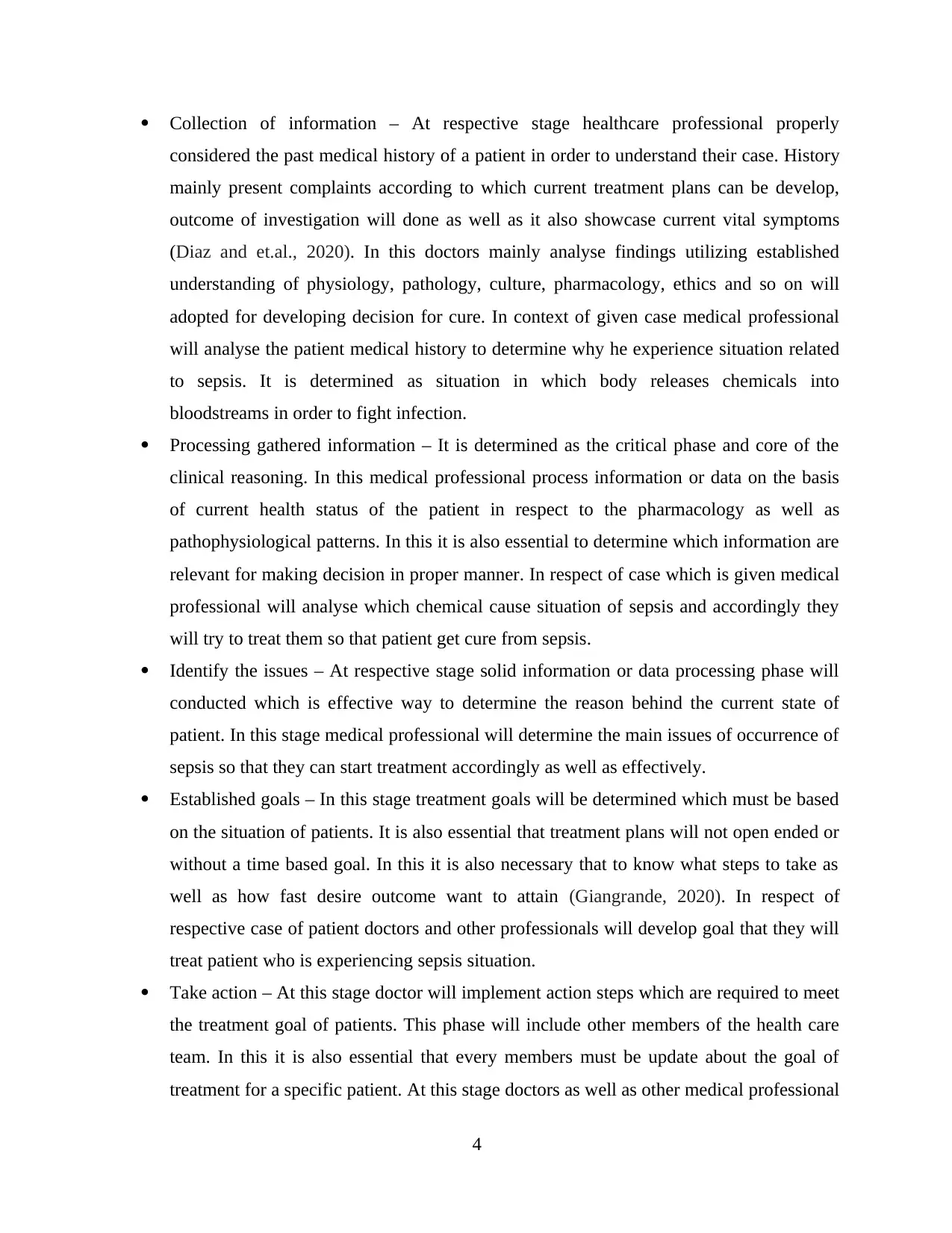
Collection of information – At respective stage healthcare professional properly
considered the past medical history of a patient in order to understand their case. History
mainly present complaints according to which current treatment plans can be develop,
outcome of investigation will done as well as it also showcase current vital symptoms
(Diaz and et.al., 2020). In this doctors mainly analyse findings utilizing established
understanding of physiology, pathology, culture, pharmacology, ethics and so on will
adopted for developing decision for cure. In context of given case medical professional
will analyse the patient medical history to determine why he experience situation related
to sepsis. It is determined as situation in which body releases chemicals into
bloodstreams in order to fight infection.
Processing gathered information – It is determined as the critical phase and core of the
clinical reasoning. In this medical professional process information or data on the basis
of current health status of the patient in respect to the pharmacology as well as
pathophysiological patterns. In this it is also essential to determine which information are
relevant for making decision in proper manner. In respect of case which is given medical
professional will analyse which chemical cause situation of sepsis and accordingly they
will try to treat them so that patient get cure from sepsis.
Identify the issues – At respective stage solid information or data processing phase will
conducted which is effective way to determine the reason behind the current state of
patient. In this stage medical professional will determine the main issues of occurrence of
sepsis so that they can start treatment accordingly as well as effectively.
Established goals – In this stage treatment goals will be determined which must be based
on the situation of patients. It is also essential that treatment plans will not open ended or
without a time based goal. In this it is also necessary that to know what steps to take as
well as how fast desire outcome want to attain (Giangrande, 2020). In respect of
respective case of patient doctors and other professionals will develop goal that they will
treat patient who is experiencing sepsis situation.
Take action – At this stage doctor will implement action steps which are required to meet
the treatment goal of patients. This phase will include other members of the health care
team. In this it is also essential that every members must be update about the goal of
treatment for a specific patient. At this stage doctors as well as other medical professional
4
considered the past medical history of a patient in order to understand their case. History
mainly present complaints according to which current treatment plans can be develop,
outcome of investigation will done as well as it also showcase current vital symptoms
(Diaz and et.al., 2020). In this doctors mainly analyse findings utilizing established
understanding of physiology, pathology, culture, pharmacology, ethics and so on will
adopted for developing decision for cure. In context of given case medical professional
will analyse the patient medical history to determine why he experience situation related
to sepsis. It is determined as situation in which body releases chemicals into
bloodstreams in order to fight infection.
Processing gathered information – It is determined as the critical phase and core of the
clinical reasoning. In this medical professional process information or data on the basis
of current health status of the patient in respect to the pharmacology as well as
pathophysiological patterns. In this it is also essential to determine which information are
relevant for making decision in proper manner. In respect of case which is given medical
professional will analyse which chemical cause situation of sepsis and accordingly they
will try to treat them so that patient get cure from sepsis.
Identify the issues – At respective stage solid information or data processing phase will
conducted which is effective way to determine the reason behind the current state of
patient. In this stage medical professional will determine the main issues of occurrence of
sepsis so that they can start treatment accordingly as well as effectively.
Established goals – In this stage treatment goals will be determined which must be based
on the situation of patients. It is also essential that treatment plans will not open ended or
without a time based goal. In this it is also necessary that to know what steps to take as
well as how fast desire outcome want to attain (Giangrande, 2020). In respect of
respective case of patient doctors and other professionals will develop goal that they will
treat patient who is experiencing sepsis situation.
Take action – At this stage doctor will implement action steps which are required to meet
the treatment goal of patients. This phase will include other members of the health care
team. In this it is also essential that every members must be update about the goal of
treatment for a specific patient. At this stage doctors as well as other medical professional
4
Secure Best Marks with AI Grader
Need help grading? Try our AI Grader for instant feedback on your assignments.
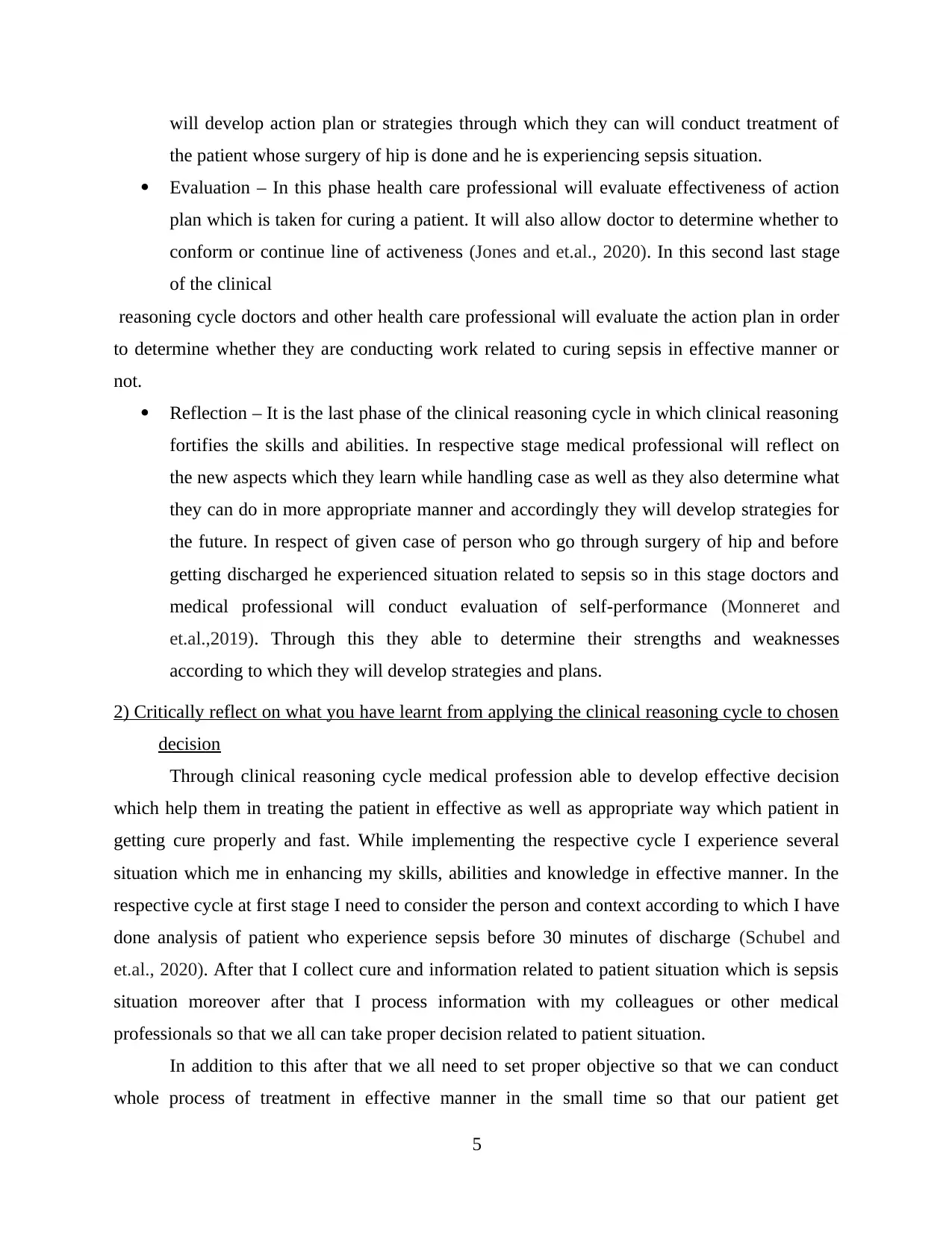
will develop action plan or strategies through which they can will conduct treatment of
the patient whose surgery of hip is done and he is experiencing sepsis situation.
Evaluation – In this phase health care professional will evaluate effectiveness of action
plan which is taken for curing a patient. It will also allow doctor to determine whether to
conform or continue line of activeness (Jones and et.al., 2020). In this second last stage
of the clinical
reasoning cycle doctors and other health care professional will evaluate the action plan in order
to determine whether they are conducting work related to curing sepsis in effective manner or
not.
Reflection – It is the last phase of the clinical reasoning cycle in which clinical reasoning
fortifies the skills and abilities. In respective stage medical professional will reflect on
the new aspects which they learn while handling case as well as they also determine what
they can do in more appropriate manner and accordingly they will develop strategies for
the future. In respect of given case of person who go through surgery of hip and before
getting discharged he experienced situation related to sepsis so in this stage doctors and
medical professional will conduct evaluation of self-performance (Monneret and
et.al.,2019). Through this they able to determine their strengths and weaknesses
according to which they will develop strategies and plans.
2) Critically reflect on what you have learnt from applying the clinical reasoning cycle to chosen
decision
Through clinical reasoning cycle medical profession able to develop effective decision
which help them in treating the patient in effective as well as appropriate way which patient in
getting cure properly and fast. While implementing the respective cycle I experience several
situation which me in enhancing my skills, abilities and knowledge in effective manner. In the
respective cycle at first stage I need to consider the person and context according to which I have
done analysis of patient who experience sepsis before 30 minutes of discharge (Schubel and
et.al., 2020). After that I collect cure and information related to patient situation which is sepsis
situation moreover after that I process information with my colleagues or other medical
professionals so that we all can take proper decision related to patient situation.
In addition to this after that we all need to set proper objective so that we can conduct
whole process of treatment in effective manner in the small time so that our patient get
5
the patient whose surgery of hip is done and he is experiencing sepsis situation.
Evaluation – In this phase health care professional will evaluate effectiveness of action
plan which is taken for curing a patient. It will also allow doctor to determine whether to
conform or continue line of activeness (Jones and et.al., 2020). In this second last stage
of the clinical
reasoning cycle doctors and other health care professional will evaluate the action plan in order
to determine whether they are conducting work related to curing sepsis in effective manner or
not.
Reflection – It is the last phase of the clinical reasoning cycle in which clinical reasoning
fortifies the skills and abilities. In respective stage medical professional will reflect on
the new aspects which they learn while handling case as well as they also determine what
they can do in more appropriate manner and accordingly they will develop strategies for
the future. In respect of given case of person who go through surgery of hip and before
getting discharged he experienced situation related to sepsis so in this stage doctors and
medical professional will conduct evaluation of self-performance (Monneret and
et.al.,2019). Through this they able to determine their strengths and weaknesses
according to which they will develop strategies and plans.
2) Critically reflect on what you have learnt from applying the clinical reasoning cycle to chosen
decision
Through clinical reasoning cycle medical profession able to develop effective decision
which help them in treating the patient in effective as well as appropriate way which patient in
getting cure properly and fast. While implementing the respective cycle I experience several
situation which me in enhancing my skills, abilities and knowledge in effective manner. In the
respective cycle at first stage I need to consider the person and context according to which I have
done analysis of patient who experience sepsis before 30 minutes of discharge (Schubel and
et.al., 2020). After that I collect cure and information related to patient situation which is sepsis
situation moreover after that I process information with my colleagues or other medical
professionals so that we all can take proper decision related to patient situation.
In addition to this after that we all need to set proper objective so that we can conduct
whole process of treatment in effective manner in the small time so that our patient get
5
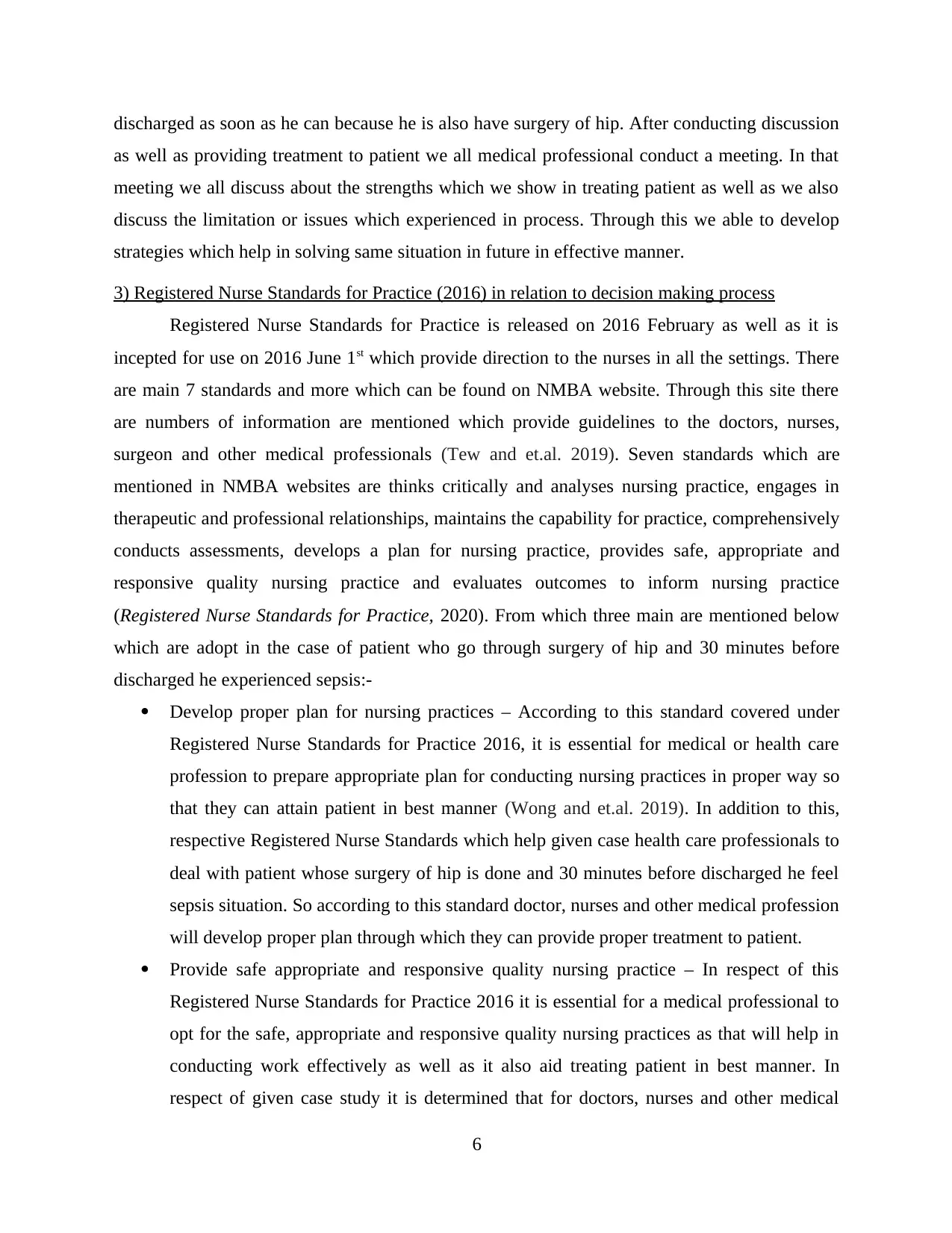
discharged as soon as he can because he is also have surgery of hip. After conducting discussion
as well as providing treatment to patient we all medical professional conduct a meeting. In that
meeting we all discuss about the strengths which we show in treating patient as well as we also
discuss the limitation or issues which experienced in process. Through this we able to develop
strategies which help in solving same situation in future in effective manner.
3) Registered Nurse Standards for Practice (2016) in relation to decision making process
Registered Nurse Standards for Practice is released on 2016 February as well as it is
incepted for use on 2016 June 1st which provide direction to the nurses in all the settings. There
are main 7 standards and more which can be found on NMBA website. Through this site there
are numbers of information are mentioned which provide guidelines to the doctors, nurses,
surgeon and other medical professionals (Tew and et.al. 2019). Seven standards which are
mentioned in NMBA websites are thinks critically and analyses nursing practice, engages in
therapeutic and professional relationships, maintains the capability for practice, comprehensively
conducts assessments, develops a plan for nursing practice, provides safe, appropriate and
responsive quality nursing practice and evaluates outcomes to inform nursing practice
(Registered Nurse Standards for Practice, 2020). From which three main are mentioned below
which are adopt in the case of patient who go through surgery of hip and 30 minutes before
discharged he experienced sepsis:-
Develop proper plan for nursing practices – According to this standard covered under
Registered Nurse Standards for Practice 2016, it is essential for medical or health care
profession to prepare appropriate plan for conducting nursing practices in proper way so
that they can attain patient in best manner (Wong and et.al. 2019). In addition to this,
respective Registered Nurse Standards which help given case health care professionals to
deal with patient whose surgery of hip is done and 30 minutes before discharged he feel
sepsis situation. So according to this standard doctor, nurses and other medical profession
will develop proper plan through which they can provide proper treatment to patient.
Provide safe appropriate and responsive quality nursing practice – In respect of this
Registered Nurse Standards for Practice 2016 it is essential for a medical professional to
opt for the safe, appropriate and responsive quality nursing practices as that will help in
conducting work effectively as well as it also aid treating patient in best manner. In
respect of given case study it is determined that for doctors, nurses and other medical
6
as well as providing treatment to patient we all medical professional conduct a meeting. In that
meeting we all discuss about the strengths which we show in treating patient as well as we also
discuss the limitation or issues which experienced in process. Through this we able to develop
strategies which help in solving same situation in future in effective manner.
3) Registered Nurse Standards for Practice (2016) in relation to decision making process
Registered Nurse Standards for Practice is released on 2016 February as well as it is
incepted for use on 2016 June 1st which provide direction to the nurses in all the settings. There
are main 7 standards and more which can be found on NMBA website. Through this site there
are numbers of information are mentioned which provide guidelines to the doctors, nurses,
surgeon and other medical professionals (Tew and et.al. 2019). Seven standards which are
mentioned in NMBA websites are thinks critically and analyses nursing practice, engages in
therapeutic and professional relationships, maintains the capability for practice, comprehensively
conducts assessments, develops a plan for nursing practice, provides safe, appropriate and
responsive quality nursing practice and evaluates outcomes to inform nursing practice
(Registered Nurse Standards for Practice, 2020). From which three main are mentioned below
which are adopt in the case of patient who go through surgery of hip and 30 minutes before
discharged he experienced sepsis:-
Develop proper plan for nursing practices – According to this standard covered under
Registered Nurse Standards for Practice 2016, it is essential for medical or health care
profession to prepare appropriate plan for conducting nursing practices in proper way so
that they can attain patient in best manner (Wong and et.al. 2019). In addition to this,
respective Registered Nurse Standards which help given case health care professionals to
deal with patient whose surgery of hip is done and 30 minutes before discharged he feel
sepsis situation. So according to this standard doctor, nurses and other medical profession
will develop proper plan through which they can provide proper treatment to patient.
Provide safe appropriate and responsive quality nursing practice – In respect of this
Registered Nurse Standards for Practice 2016 it is essential for a medical professional to
opt for the safe, appropriate and responsive quality nursing practices as that will help in
conducting work effectively as well as it also aid treating patient in best manner. In
respect of given case study it is determined that for doctors, nurses and other medical
6
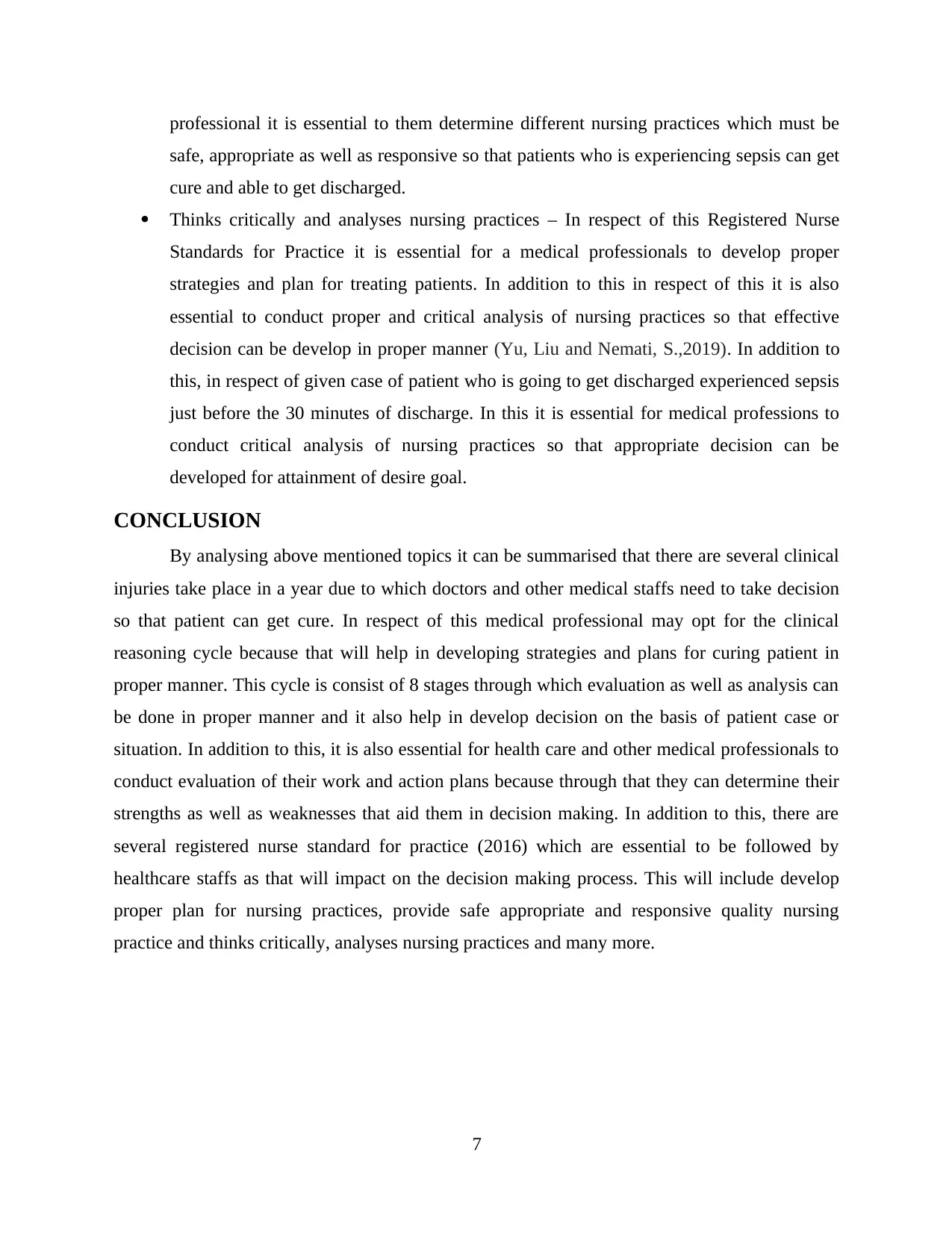
professional it is essential to them determine different nursing practices which must be
safe, appropriate as well as responsive so that patients who is experiencing sepsis can get
cure and able to get discharged.
Thinks critically and analyses nursing practices – In respect of this Registered Nurse
Standards for Practice it is essential for a medical professionals to develop proper
strategies and plan for treating patients. In addition to this in respect of this it is also
essential to conduct proper and critical analysis of nursing practices so that effective
decision can be develop in proper manner (Yu, Liu and Nemati, S.,2019). In addition to
this, in respect of given case of patient who is going to get discharged experienced sepsis
just before the 30 minutes of discharge. In this it is essential for medical professions to
conduct critical analysis of nursing practices so that appropriate decision can be
developed for attainment of desire goal.
CONCLUSION
By analysing above mentioned topics it can be summarised that there are several clinical
injuries take place in a year due to which doctors and other medical staffs need to take decision
so that patient can get cure. In respect of this medical professional may opt for the clinical
reasoning cycle because that will help in developing strategies and plans for curing patient in
proper manner. This cycle is consist of 8 stages through which evaluation as well as analysis can
be done in proper manner and it also help in develop decision on the basis of patient case or
situation. In addition to this, it is also essential for health care and other medical professionals to
conduct evaluation of their work and action plans because through that they can determine their
strengths as well as weaknesses that aid them in decision making. In addition to this, there are
several registered nurse standard for practice (2016) which are essential to be followed by
healthcare staffs as that will impact on the decision making process. This will include develop
proper plan for nursing practices, provide safe appropriate and responsive quality nursing
practice and thinks critically, analyses nursing practices and many more.
7
safe, appropriate as well as responsive so that patients who is experiencing sepsis can get
cure and able to get discharged.
Thinks critically and analyses nursing practices – In respect of this Registered Nurse
Standards for Practice it is essential for a medical professionals to develop proper
strategies and plan for treating patients. In addition to this in respect of this it is also
essential to conduct proper and critical analysis of nursing practices so that effective
decision can be develop in proper manner (Yu, Liu and Nemati, S.,2019). In addition to
this, in respect of given case of patient who is going to get discharged experienced sepsis
just before the 30 minutes of discharge. In this it is essential for medical professions to
conduct critical analysis of nursing practices so that appropriate decision can be
developed for attainment of desire goal.
CONCLUSION
By analysing above mentioned topics it can be summarised that there are several clinical
injuries take place in a year due to which doctors and other medical staffs need to take decision
so that patient can get cure. In respect of this medical professional may opt for the clinical
reasoning cycle because that will help in developing strategies and plans for curing patient in
proper manner. This cycle is consist of 8 stages through which evaluation as well as analysis can
be done in proper manner and it also help in develop decision on the basis of patient case or
situation. In addition to this, it is also essential for health care and other medical professionals to
conduct evaluation of their work and action plans because through that they can determine their
strengths as well as weaknesses that aid them in decision making. In addition to this, there are
several registered nurse standard for practice (2016) which are essential to be followed by
healthcare staffs as that will impact on the decision making process. This will include develop
proper plan for nursing practices, provide safe appropriate and responsive quality nursing
practice and thinks critically, analyses nursing practices and many more.
7
Paraphrase This Document
Need a fresh take? Get an instant paraphrase of this document with our AI Paraphraser
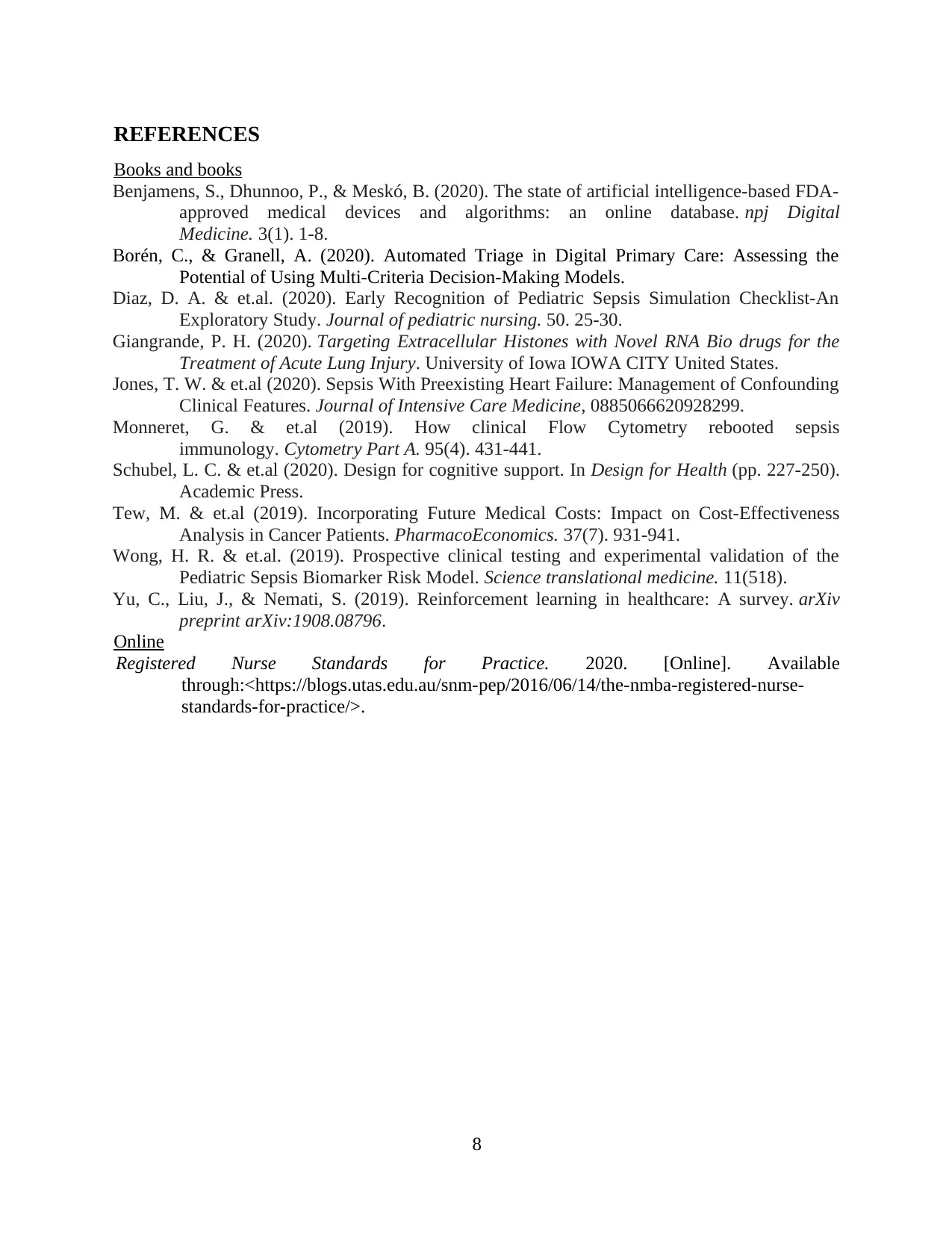
REFERENCES
Books and books
Benjamens, S., Dhunnoo, P., & Meskó, B. (2020). The state of artificial intelligence-based FDA-
approved medical devices and algorithms: an online database. npj Digital
Medicine. 3(1). 1-8.
Borén, C., & Granell, A. (2020). Automated Triage in Digital Primary Care: Assessing the
Potential of Using Multi-Criteria Decision-Making Models.
Diaz, D. A. & et.al. (2020). Early Recognition of Pediatric Sepsis Simulation Checklist-An
Exploratory Study. Journal of pediatric nursing. 50. 25-30.
Giangrande, P. H. (2020). Targeting Extracellular Histones with Novel RNA Bio drugs for the
Treatment of Acute Lung Injury. University of Iowa IOWA CITY United States.
Jones, T. W. & et.al (2020). Sepsis With Preexisting Heart Failure: Management of Confounding
Clinical Features. Journal of Intensive Care Medicine, 0885066620928299.
Monneret, G. & et.al (2019). How clinical Flow Cytometry rebooted sepsis
immunology. Cytometry Part A. 95(4). 431-441.
Schubel, L. C. & et.al (2020). Design for cognitive support. In Design for Health (pp. 227-250).
Academic Press.
Tew, M. & et.al (2019). Incorporating Future Medical Costs: Impact on Cost-Effectiveness
Analysis in Cancer Patients. PharmacoEconomics. 37(7). 931-941.
Wong, H. R. & et.al. (2019). Prospective clinical testing and experimental validation of the
Pediatric Sepsis Biomarker Risk Model. Science translational medicine. 11(518).
Yu, C., Liu, J., & Nemati, S. (2019). Reinforcement learning in healthcare: A survey. arXiv
preprint arXiv:1908.08796.
Online
Registered Nurse Standards for Practice. 2020. [Online]. Available
through:<https://blogs.utas.edu.au/snm-pep/2016/06/14/the-nmba-registered-nurse-
standards-for-practice/>.
8
Books and books
Benjamens, S., Dhunnoo, P., & Meskó, B. (2020). The state of artificial intelligence-based FDA-
approved medical devices and algorithms: an online database. npj Digital
Medicine. 3(1). 1-8.
Borén, C., & Granell, A. (2020). Automated Triage in Digital Primary Care: Assessing the
Potential of Using Multi-Criteria Decision-Making Models.
Diaz, D. A. & et.al. (2020). Early Recognition of Pediatric Sepsis Simulation Checklist-An
Exploratory Study. Journal of pediatric nursing. 50. 25-30.
Giangrande, P. H. (2020). Targeting Extracellular Histones with Novel RNA Bio drugs for the
Treatment of Acute Lung Injury. University of Iowa IOWA CITY United States.
Jones, T. W. & et.al (2020). Sepsis With Preexisting Heart Failure: Management of Confounding
Clinical Features. Journal of Intensive Care Medicine, 0885066620928299.
Monneret, G. & et.al (2019). How clinical Flow Cytometry rebooted sepsis
immunology. Cytometry Part A. 95(4). 431-441.
Schubel, L. C. & et.al (2020). Design for cognitive support. In Design for Health (pp. 227-250).
Academic Press.
Tew, M. & et.al (2019). Incorporating Future Medical Costs: Impact on Cost-Effectiveness
Analysis in Cancer Patients. PharmacoEconomics. 37(7). 931-941.
Wong, H. R. & et.al. (2019). Prospective clinical testing and experimental validation of the
Pediatric Sepsis Biomarker Risk Model. Science translational medicine. 11(518).
Yu, C., Liu, J., & Nemati, S. (2019). Reinforcement learning in healthcare: A survey. arXiv
preprint arXiv:1908.08796.
Online
Registered Nurse Standards for Practice. 2020. [Online]. Available
through:<https://blogs.utas.edu.au/snm-pep/2016/06/14/the-nmba-registered-nurse-
standards-for-practice/>.
8
1 out of 8
Related Documents
Your All-in-One AI-Powered Toolkit for Academic Success.
+13062052269
info@desklib.com
Available 24*7 on WhatsApp / Email
![[object Object]](/_next/static/media/star-bottom.7253800d.svg)
Unlock your academic potential
© 2024 | Zucol Services PVT LTD | All rights reserved.





